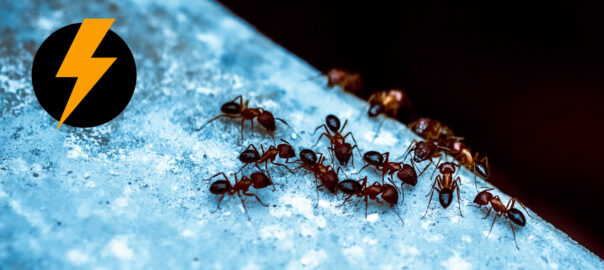Pet-Friendly Pest Control
- (541) 636-0146
- Schedule Service

Ants are fascinating creatures known for their industrious nature and complex social structures. However, when they invade our homes, they become unwelcome guests, foraging for food and water and often building colonies within our living spaces. Food preparation areas, such as a kitchen counter with a few sugary treats or spilled juice, are very appetizing places for ants to collect.
But we can’t just think of our food as an ant’s only meal source. There’s plenty more to attract and feed them than what didn’t make it into your garbage can.
In this comprehensive guide, we’ll explore what attracts ants to a home, how they find their way inside, and how to prevent infestations. We’ll also discuss ways to prevent ants from seeking out water in your home and offer advice on safe ant-removal methods, including when to know if it’s time to call for professional pest control.
Ants are primarily attracted to homes for two essential resources: food and water. Understanding their behavior and motivations is the first step in effective ant prevention and control.
Ants can get their food supply from the following:
Ants are thirsty little buggers. They require water to survive, so they are naturally drawn to damp areas in your home. Not only are they looking for a drink at the moment, but they actually carry it back to their colonies to store. These are where ants get their water:
Condensation. Ants can also extract moisture from condensation on windows, walls, and appliances.
Ants don’t just build colonies underground or in sidewalk cracks. They are one of the most common insects to make your home their own. But before ants can make a snack out of pet food or the droplets of spilled watermelon juice you didn’t notice, they need to find a way inside. Given their size and sheer will, ants won’t have a difficult time finding their way into your home.
Open windows and doors are the most obvious option and the easiest to remedy. However, they’re savvy enough to find the smallest of cracks or gaps in walls, vents, baseboards, and even foundation walls so they can find a safe place to build their colonies. They want a space that’s warm (and we know that warmth is often provided by a nice, damp room), close to food and water, and dark—and once they’re in, they can cause a lot of damage to walls, wiring, and insulation.
Although ants might not be the first pests we associate with harming our house plants, they are indeed drawn to them. Flowers and fragrant plants lure ants, and occasionally, ants even act as pollinators. They prefer low-lying plants with smaller flowers, with some exceptions. In particular, ants are most drawn to peonies, which are not known for their small size. These ants can often be seen foraging on flowers, gathering nectar for their food supply.
Ants are highly adaptable creatures with diverse dietary preferences, so another reason you may see ants on your flowers and potted plants is the nectar left behind from aphids. Many ant species, including the notorious Argentine ant, engage in a mutualistic relationship with aphids. Ants “farm” aphids on plants, protecting them from predators and “milking” them for honeydew, a sugary secretion. In return, ants provide protection and even transport aphids to fresh plants. This relationship often takes ants to trees and plants where aphids are present.
They may also be attracted to your plants and trees for a very different reason: these two are a bridge into your home. We’ve already determined that ants want a safe, dark home, and the plant life surrounding you may be their way in. Where possible, creating distance between your home (or any openings in it) and trees or plants will be helpful if you’re noticing an ant infestation.
Carpenter ants and fire ants are two types of ants that can pose specific challenges when they infest homes. Carpenter ants nest in wood and can cause structural damage. To get rid of carpenter ants, locate and remove the nest by following worker ants to their colony. As with other ant species, eliminate moisture sources that attract carpenter ants. And if all else fails, consult a pest-control professional for severe infestations, since locating and treating carpenter ant nests can be challenging.
Meanwhile, fire ants are known for their painful stings and aggressive behavior, but you can control fire ant colonies or mounds with bait or insecticides. Maintain a fire ant management plan for your property to prevent re-infestation.
Preventing an ant infestation starts with eliminating the reasons for what attracts ants: reducing the ants’ access to food, water, and entry points. Here are some effective preventive measures you can take before you decide to call pest control.
When dealing with an ant infestation, it’s crucial to prioritize safety and choose the right approach. Use bait traps and ant baits containing slow-acting pesticides to allow ants to carry the bait back to the nest, effectively eliminating the colony. Avoid using harmful chemicals that can pose risks to pets, children, and the environment. Consult with a pest control professional if the infestation persists or if you have concerns about the type of ant species involved.
While many ant infestations can be managed through preventive measures and DIY solutions, there are situations where professional pest control assistance is necessary:
If you’re worried your ant problem is more than just a few bugs surrounding leftover cookie crumbs, don’t try fixing these things by yourself. Let Bug Zapper help you! With our personalized approach, high-quality and effective products, and expertise, we can get rid of your ant problem efficiently. Call us today to learn more about our pest control services.
Understanding what attracts ants to your home, their sources of food and water, and their nesting habits is key to effective prevention and management. By adopting preventive measures, safely addressing infestations, and seeking professional assistance when needed, you can keep your home ant-free and enjoy a pest-free living environment.
Ultimately, ants are looking for the same thing all of us want: a safe, warm place to live and eat. While you shouldn’t make your home any less safe or comfortable, you can make it harder for ants to enter or even less desirable for them to stay long-term.



